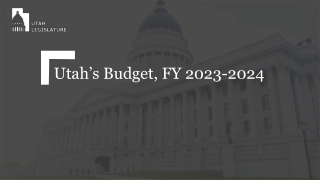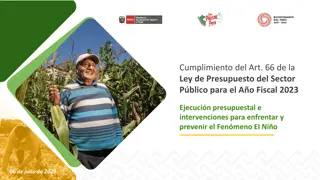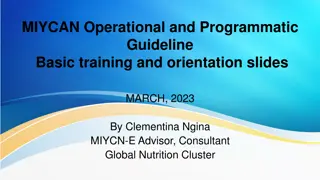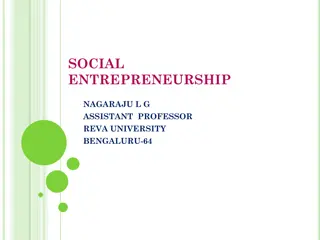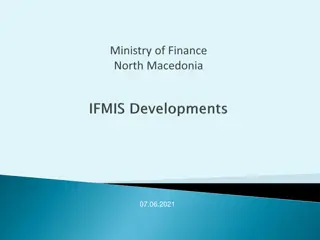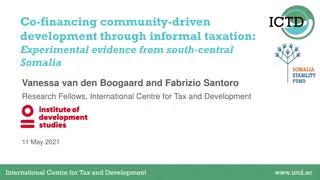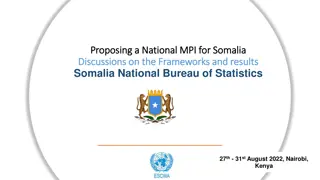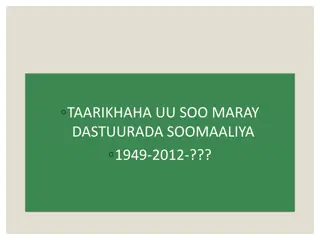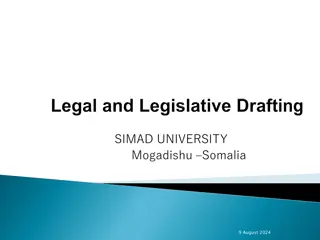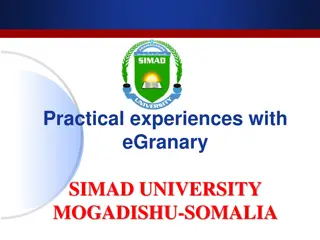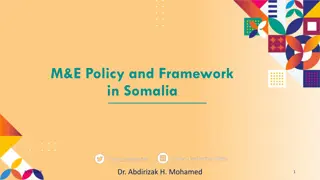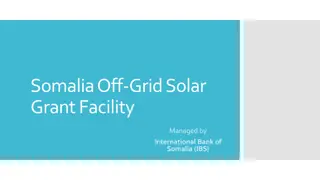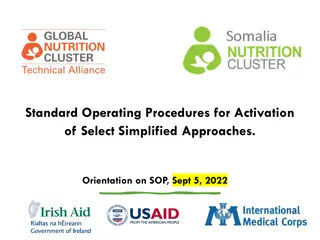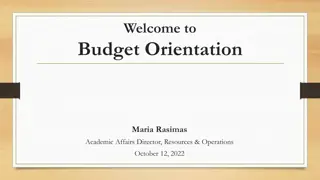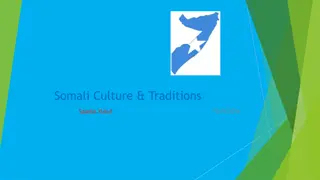Budget Execution Challenges in Somalia's Social Sectors
Addressing malnutrition in Somalia is hindered by low budget execution rates in the health and education sectors. Only a small portion of Official Development Assistance (ODA) is channeled through government systems, impacting service delivery and development financing. Donor-supported budgets for health and education exhibit extremely low execution rates compared to other sectors, highlighting management challenges in donor funds. The 2023 budget allocation shows a decline in funding for the social sector, affecting important projects like SOMCOVID under the Ministry of Health.
Download Presentation

Please find below an Image/Link to download the presentation.
The content on the website is provided AS IS for your information and personal use only. It may not be sold, licensed, or shared on other websites without obtaining consent from the author.If you encounter any issues during the download, it is possible that the publisher has removed the file from their server.
You are allowed to download the files provided on this website for personal or commercial use, subject to the condition that they are used lawfully. All files are the property of their respective owners.
The content on the website is provided AS IS for your information and personal use only. It may not be sold, licensed, or shared on other websites without obtaining consent from the author.
E N D
Presentation Transcript
Low Budget Execution Low Budget Execution Rates in Health and Rates in Health and Education Education Federal Government of Somalia Federal Government of Somalia Ocean Stars Ocean Stars November 7 November 7- -9, Cape Town, South Africa Cape Town, South Africa 9, 2023 2023
Determining the Problem Determining the Problem The initial problem we wanted to tackle was malnutrition for its significance in Somalia, where an estimated 43% of the population is facing food insecurity of which 50% are children. This presented many problems in relation to linking the problem to public financial management, given the country s high reliance on donor support, and off-budget support related to nutrition whereby only 14% of ODA (~ $2 billion) goes through the government systems. However, looking at the ODA that go through the budget, we identified very low budget execution rates, particularly in the ministry of health, and the ministry of education. This issue is not only relevant to health and education but is itself an entry point to reforming processes and financial flows within government and from donors to government, critical for service delivery and development financing, including in sectors that impact sustainable inclusive growth and nutrition targets.
Budget Execution Rates in Health and Education Budget Execution Rates Health and Education 90% 80% 76% 76% 70% 72% 66% 60% 50% 48% 40% 38% 38% 30% 35% 31% 20% 19% 10% 16% 0% 6% 2020 2018 2019 2021 2022 Ministry of Health Ministry of Education Ministry of Health-donor Ministry of Education-donor Budget execution rates in social sectors, specifically donor-supported budgets in health and in education (Around US$ 59 million and US$ 31 million respectively) are extremely low compared to other sectors and functions, specifically local recurrent expenditures, highlighting challenges in the management of donor funds, development financing and intergovernmental transfers.
Somalia 2023 budget across sectors 2023 EXPENDITURE ALLOCATION BY SECTORS (IN MILLIONS OF $ $400.00 $346.71 $350.00 $300.00 $261.30 $250.00 $197.90 $200.00 $172.60 $150.00 $100.00 $50.00 35% 27% 20% 18% $0.00 Administrative Sector Defence and Security Economic Sector Social Sector
The social sector spending in 2023 The social ministries experienced budget decline in the 2023 supplemental review. In the revised budget, the social sector received $243.2 million. The budget document captures that the social sector figures experienced a decline of $18.1 million (-7%) from the original estimates of $261.3 million. SOMCOVID project under the delivery of the Ministry of Health was hit hard by receiving allocations of less than $15 million from the original spending plans of $49.3 million. This startling decline is attributed to the decrease of grants from the World Bank for capital projects.
Donor funding across sectors 100% 95% 86% 90% 81% 80% 70% 70% 60% 52% 50% 45% 44% 40% 32% 29% 30% 24% 20% 10% 0% 2018 2019 Ministry of Health 2020 2021 2022 Ministry of Education
Why Does the Problem Matter? Why Does the Problem Matter? From an outcome perspective From a technical Perspective The estimated out of school children is around 4 million, or 60% of school aged children (~6.6 million). Of children who are enrolled, more than 50 per cent attend private schools. Somalia has a high fertility rate (~5.7) so there is a large need for maternal and early childhood health services. External shocks, including drought and a high disease burden, impact malnutrition and child mortality rates (~62.8/1000), which require significant expansion in health interventions and treatment. Expanding budget execution rates would help improve conditions for households and children in education and health and contribute to human capital development. Large gaps between development budgets and the execution of those budgets correspond to many challenges. Their impact is not only related to lost opportunities but also a distortion of expectations, trust, and future planning processes. For example, expectations of low execution rates may lead to over-budgeting, and ineffective program design to make up for anticipated allocation shortfalls. Unexecuted budgets, affect trust of funding entities or process, whether donors, debtors or tax-payers (particularly those related to development or service delivery projects), reducing commitment of funds, investment, and tax compliance. The World Bank, the financier of this budget components in Health and Education has shown dissatisfaction of this low budget execution rates, which may result much of funds to expire due to its low utilization rates.
Entry Points and Ideas for Action Entry Points and Ideas for Action
Feasibility of Entry Points 10 9 8 3 7 2 3 Acceptance 6 2 3 1 1 5 2 2 2 2 1 3 3 3 4 2 2 2 2 2 Ability 1 3 3 1 1 3 3 2 2 2 2 3 2 2 2 2 2 2 Authority 3 1 1 3 3 3 3 3 1 2 2 2 2 2 1 1 1 1 1 1 1 1 0
Action Point 3: Capacity Development to Reduce Delays in Reporting and Fund Disbursements Auditor General Registration Project included in the budget Warranty Voucher Signed by Budget Department Project approval by Donor AG Approval Project approval cycle: CB Payment to Implementing Partner MDAs submit Payment Voucher to AG AG approves Monthly Expenditure Statement Bottlenecks in reporting Donors Process and Release additional Funds Accountant General Reviews and Uploads FMS Reviews Implementation Quarterly progress and financial report Capacity and system building can reduce reporting delays and simplify accountable processes to smooth financial flows within government and from donor to government
Entry points identified and how they relate to the overall problem The identified entry points are directly related to the low budget execution rates in Somalia's health and education ministries. These entry points address the challenges and factors that impact service delivery in Somalia, particularly in the social sector. These entry points further offer opportunities to: Address the challenges in public financial management reform processes, and financial flows within the government and from donors. No modifications were made to the entry points since the framing workshop.
Initial ideas the team wanted to implement and progress made The initial ideas that the team wanted to tackle remained the same as identified during the framing workshop in February which was Capacity development for finance and planning staff in Health and Education Ministries . Due to complexity of most deconstructed problems and associated bottlenecks in finding solutions, the team focused on Capacity Development to Reduce Delays in Reporting and Fund Disbursements as entry point for this intervention.
New insight and data gathered on the entry points Assessed the capacity gaps in Ministries, Departments, and Agencies (MDAs), with special focus on Social Ministries, particularly Health and Education. The primary aim of this assessment was to identify the challenges and problems associated with staff capacity that relates to low budget execution and provide recommendations for improving public financial management. To determine this capacity gap assumption, the team embarked a survey through: Developed questionnaire and designed data collection tools Identified key MDAs departments for data collection Assigned team members to different MDAs, Collected data from target respondents Analyzed data and presented the study findings report
New insight and data gathered on the entry points The data findings highlighted a capacity improvement need for finance staff in Health and Education Ministries as well as other MDAs The findings further recommended MDAs finance and planning staff capacity enhancement in the following areas: Budget forecasting, Costing, Reporting and Monitoring Program-Based budget (PBB) in Excel training Financial Management for government funded and donor funded projects (Off/On budget) Procurement and Logistics Somalia Financial Management Information System (SFMIS) training It further noted institutional arrangement gaps in MDAs and recommended restructuring the finance sections with establishment of budget planning, execution and reporting units particularly tasked to lead budgetary issues to solve the low execution rates as well as improve budget forecasting and estimation during formulation stage. Due to Somalia s nascent public finance management reforms in this federated system and absence of key PFM regulatory frameworks; implementation of this institutional arrangement policy recommendation may take some time.
New learnings/lessons about the entry points, problem and assumptions that were revisited The new lessons learnt through assessment indicate an urgent need for the following interventions: Training staff for the Ministry of Health and Ministry of Education to improve budget planning, execution and reporting knowledge and skills. Addressing the Institutional arrangement gaps within the Ministries by restructuring finance departments The team realized the need for inclusion of the Federal Member States (FMSs) ministries staff into the future PDIA trainings After carefully deliberating the problem statement, the team agreed to stick with the initial assumption
Challenges faced in implementing ideas and how the team addressed Lack of funds to implement the assessment recommendations. Government is putting substantial efforts and resources towards the security sector To address these challenges, the team worked with UNICEF to find ways to fund these activities to tackle this low budget execution rates in Health and Education Similarly, the team engaged the relevant stakeholders to address the aforementioned challenges
Measure of Success Measure of Success
Measures of success Due to the multifaceted political and technical demands of the most problems identified; the team focused on one entry point which is Gaps in the capacity of staff in financial management e.g. budgeting, forecasting & reporting including the use of SFMIS . Below are the measures of success for our Entry point: After capacity development in public finance management; we anticipated that 55% of Finance staff in Health and Education ministries will have sufficient knowledge on budget preparation, execution and reporting through the use of Somalia Financial Information Management System (SFMIS). Relevant departments such as finance and planning will have the required knowledge on Budget planning, execution & reporting procedures to reduce low execution rates. Ministries of Health and Education will have dedicated staff for budget management including forecasting, execution and reporting. Budget officers from both MoF and MDAs will have greater oversight in budget execution monitoring and will bring corrective measures when required. Transfers to FMSs will be enhanced as the budget reporting deadlines are achieved on time.
Progress against the entry points and where they have been Progress against the entry points and where they have been refined or eliminated refined or eliminated A survey questionnaire have been conducted in which the participants were asked to respond on some key issues related to budget planning and management to assess the level of capacity that the finance staff currently possess. Feedback has been received from 34 officials from Ministries, departments & agencies; particularly DGs, Director of admin and finance and other relevant directors. Ministry of Health and Ministry of Education were the focus. The study noted that there is a need for capacity development for staff in budget planning and management. No change or elimination were made to the entry points since the framing workshop in February.
Working in new ways and Building Capabilities Working in new ways and Building Capabilities
New ways of thinking and approach to PFM challenges Recommended institutional arrangements within the MDAs by establishing units with specific budget formulation and execution tasks to fill the institutional gaps and reduce the burden on the administration and finance directorates. The establishment of the following additional roles was recommended to perform budget management tasks in line ministries finance functions to improve budget execution rates. Head of Budget Unit Budget Officer Reporting Officer PDIA introduction to the Federal State Ministries staff to learn problem-solving process and approaches in finding solutions to PFM challenges. Most donor funded service delivery programs are implemented in districts in the federal states (FMSs).
Approach to teamwork, meeting and team dynamics Conflicting schedules and individual routine tasks were challenge where sometimes planned meetings or activities delayed due to absence of the most of the team. To address the challenges, the team agreed available members (minimum three) to do work and update other members for input and finalization. Apart from the conflicting schedules the team was dynamic in terms of composition; with clear roles and responsibilities.
Changes in ways authorisers are consulted or involved The authoriser is part of the team and contributes to whole the PDIA process to solve PFM challenges. Provides recommendations on ways to approach the process and leverages his office s mandate to coordinate the activities. All interventions are done in consultative process with consent of the authoriser and the whole team as well.
Challenges in applying the PDIA approach and participating in the BPFCC There is lack of political commitment in adopting change, hence difficult to have a uniform perspective in deconstructing problems Inadequate understanding of the PDIA concept, therefore difficult to implement and cascade it down in the government hierarchy. Due to Somalia s multipart political system structure and absence of key institutional mechanisms for PFM reforms posed a challenge in applying PDIA approach. Single layer (federal level) of the political structure is participating in this PDIA process to improve problem-solving skills while the second layer (federal states) not included to participate in this process. Federal States are where the most donor funded service delivery programs occur and some of the problems identified in the fishbone exist as well. No inter-governmental fiscal transfer mechanism framework.
Next Steps Next Steps
G oals and planned activities over the next six m onths The primary goal is to strengthen the capacity of the finance staff in Health and Education Ministries. Consult with the relevant stakeholders to create a momentum to address institutional arrangement gaps.
C apacity developm ent interventions Conduct series of capacity building sessions to align the strategies and guidelines of the Somalia Public Financial Management Act of 2019. The objective of the capacity building is to sensitize MDAs and key stakeholders on the requirements of the PFM Act 2019, while using the country systems in the event of receiving external assistance. For purposes of this activity, the scope of PFM capacity development is limited to the following: Budget forecasting, Costing, Reporting and Monitoring Program-Based budget (PBB) training Financial Management for government funded and donor funded projects (Off/On budget) Procurement and Logistics Somalia Financial Management Information System (SFMIS) training
Institutional arrangem ents G ap Establishing Budget units in Line Ministries to lead budgeting tasks inclusive of formulation, execution, reporting namely; Head of Budget Unit Budget Officer Budget Reporting Officer To realize this change, in the next few months, a consultative forums will be organized to bring together MDAs Director Generals and relevant technical experts for institutional recommendation and ways to implement this holistic policy decision. reforms to discuss this
K now ledge Im provem ent M easurem ents Conduct post capacity building assessment to examine skills enhancement in participating MDA staff as well as assess improvement in execution rates in health and education budget executions. To cascade the training to the Federal Member States especially social ministries
Thanks You!!! Obrigado!!! Mahadsanidiin!!!



